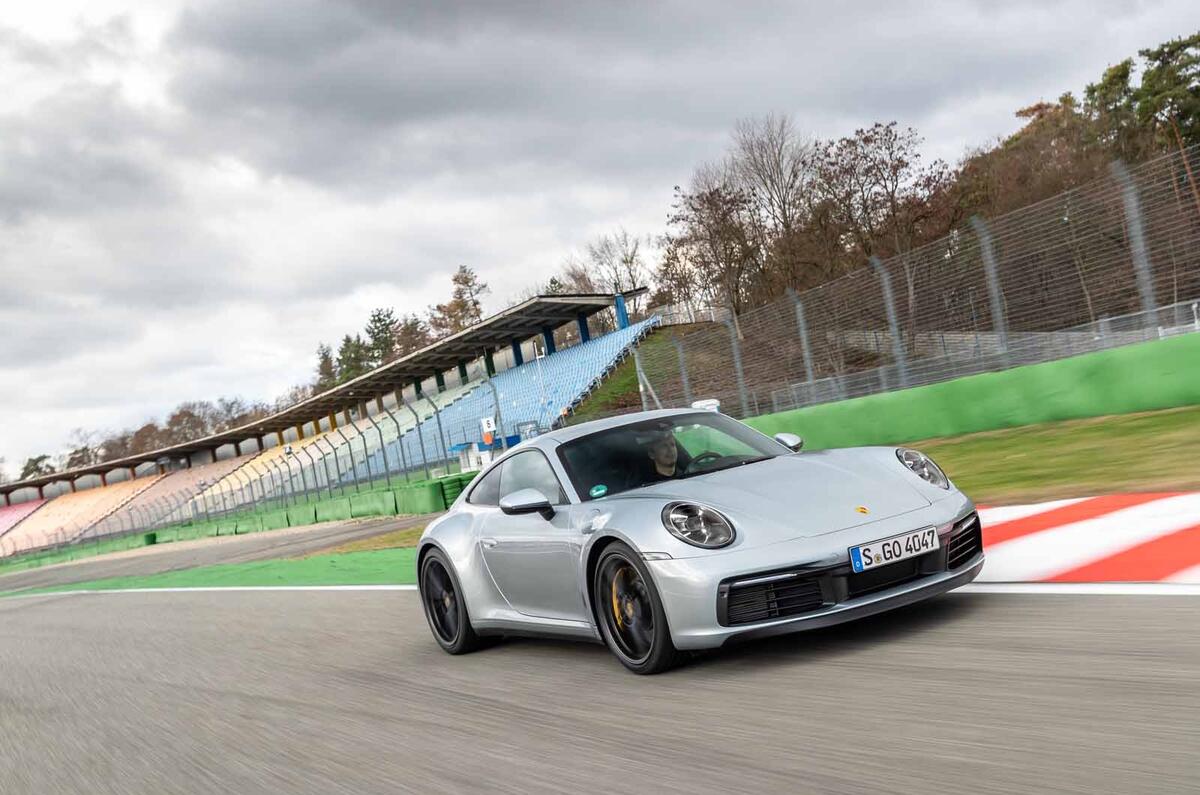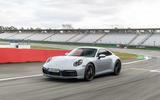Whether it was the noise of the flat-six engine from behind, or the slight burst of oversteer as my driver attempted to apply that unit’s 444bhp through cold rear tyres, a ride around Hockenheim proved that much is reassuringly familiar about the new Porsche 911 Carrera S.
That’s entirely by design, of course. As Porsche’s R&D boss, Michael Steiner, notes, since it was first launched in 1963, the 911 has “been the main pillar of the brand”.
So the new 992-generation machine is understandably evolutionary, both in terms of design and driving dynamics. But don’t mistake evolution for a lack of change. As with the car’s design, which freshens the 911’s look while respecting the past, under the bodywork there are plenty of small details and changes. Porsche’s engineers believe that these, in the best spirit of ‘marginal gains’, add up to make a big difference.
A good example of that is how the engine is mounted to the chassis. On every previous 911, dating back to the 1963 original, the engine was mounted via a bracket attached to the crankcase. But on the new car, it’s been mounted directly into the longitudinal members, around 20cm further forward.
New 992-series Porsche 911: details of mild hybrid and plug-in hybrid versions
That has been done to reduce the engine vibrations and improve stability. It does so by a matter of degrees, but when combined with the new lightweight yet stiffer shell (which uses significantly more aluminium), Porsche says it makes a notable difference.
How big a difference do all the improvements to the new car make? In Nürburgring terms, about five seconds: that’s how much quicker Porsche says the new Carrera S is around that track than the previous model.
While a 7min 25sec lap of the Nordschleife is impressive, our first chance to experience the finished version of the new machine (we previously had a ride in a late prototype) came at another German F1 track.
First impressions of the new Porsche 911
The design evolution is clear both when you see the 911 in the Hockenheim paddock and when you sit inside it. From the passenger seat, the 911 is comfortable and spacious. The new 10.9in infotainment system is notable, as are the two seven-inch digital display screens on the dashboard – but front and centre behind the steering wheel is a good old-fashioned analogue rev counter.
New Porsche 911 Cabriolet detailed in revealing spy shots
That balance between luxury and old-school sports car is key to the development of the new 911. “We wanted to make it sportier, but also more usable in day-to-day life,” said Steiner.
To achieve that, the 911 features a whole host of new digital and driver assistance systems, which are tuned to widen its performance window, from driver-focused performance at one extreme, to cruising comfort at the other.
So, for example, the new dual-clutch eight-speed PDK gearbox – the only unit available at launch – which Porsche says has been set for faster gearchanges at low speeds, and greater fuel economy at high speed.
If you use the throttle aggressively, it will automatically hold gears longer, and it uses GPS and data gathered from the car sensors to predict traffic, bends or hills ahead, adjusting the shift pattern to ensure maximum response.
At speed in the new 911 Carrera S
With a racing driver behind the wheel and on the wide expanse of Hockenheim, it’s very much the sporting end of the new 911’s performance window that I get to experience for a short ride.
We take one lap in Normal mode, which also helps to get the aforementioned cold tyres up to speed, before switching to Sport Plus. In that mode, you can feel the increased revs and effort of the twin-turbocharged flat-six 3.0-litre engine. With an extra 30bhp than previously and 391lb ft of torque at its disposal (up from 325lb ft), that unit provides plenty of momentum coming out of corners, and you can feel how the eight-speed dual clutch holds gears for longer, giving more response.
The classic 911 balance is clear, and the new car’s more direct steering is reflected in the driver’s confidence as he lifts off the brakes and turns into corners.
The new 911 uses new tyres and differing wheel sizes: 20in on the front and 21in (and wider) tyres at the rear. This motorsport-inspired set-up, only previously seen in the previous-generation 911 on the GT2 RS and GT3 RS, is designed to improve the car’s balance and traction, and also to help balance tyre temperature better – always a key consideration on the rear-engined, rear-wheel-drive 911.
The Porsche 911’s new Wet Mode
Our run ends with a blast around a wet handling track, to showcase one of the new 911’s novel driver assistance features: a new Wet Mode.
The car features a sensor located in the front wheel arch that detects spray thrown up from the road, pre-conditioning the safety systems and recommending to the driver to engage Wet Mode. When they do, the traction control and braking systems are increased, the brake balance is shifted forward, throttle response is dampened and the rear wing is deployed to maximise downforce.
We take a lap in Normal mode, the driver working hard to drive as badly as he can in the conditions, and experience plenty of sideways action – fun on a wide-open expanse of Tarmac, likely less so on a real wet road.
With Wet Mode engaged, you can feel how much harder the traction control and other systems work to combat attempts by our driver to get sideways, with a notable difference in the car’s wayward attitude.
Porsche says a considerable focus of the chassis and tyre development went into improving handling and safety in wet conditions, and that’s certainly demonstrated by the new mode.
Why the new Porsche 911 feels a welcome evolution
A few passenger laps of an F1 track and a wet car park aren’t enough to really judge a new car, of course, but they did provide a welcome first impression of the new 911.
That impression is of a car that is at once a step forward, while also remaining reassuringly familiar. There’s an added sheen of comfort with the development of the touchscreens and displays in the interior, and with the addition of new driver assistance systems.
Yet those systems appear to have been developed to give those who want to exploit its considerable performance the freedom to do so. Which, when we’re given the opportunity to try the new 911 from the driver’s seat, we very much intend to do.
Read more
New 2019 Porsche 911: eighth-generation sports car revealed
New Porsche 911 Cabriolet detailed in revealing spy shots
New 992-series Porsche 911: new details of mild hybrid and plug-in hybrid versions



































Join the debate
Add your comment
Oozes understated charisma...
like no other sports car. Only wish they'd moved the side-indicator on the front fender to the side-mirror. Would have made for an even cleaner look.
More of the same....
The ring laptime for the 992 is nothing short of staggering - 5 secs faster is incredible.
I love the small detail nods to the past, like the indents in the back of the bonnet, shape of the dash binnacle and background of the central rev counter (though I would still rather have 5 analogue dials).
I'm pleased that despite the S and 4S now sharing the same body shell, the width remains relatively compact at 185cms.
No doubt the engine and new 8 speed PDK will deliver and I expect Porsche is now getting into it's stride with the new 3.0 turbo unit.
It's a pity the old PDK selector has been replaced by what amounts to a toggle switch but that's one of few gripes I have about the interior.
The new seats look more comfortable and I can't wait to get behind the wheel.
Porsche may be a very different company than it used to be but it seems even under Volkswagen, their stewardship of the iconic 911 is in safe hands.
911 the 'Vanilla' Edition
Seems Porsche is making each successive 911 more 'Vanilla', the Honda Accord of the supercar world. That's not necessarily a criticism, actually it's more of a compliment, but it leaves the gap between the regular cars and the GT cars greater than ever, and makes the GT cars, to my mind, even more desirble, and therefore unfortunately even less attainable.